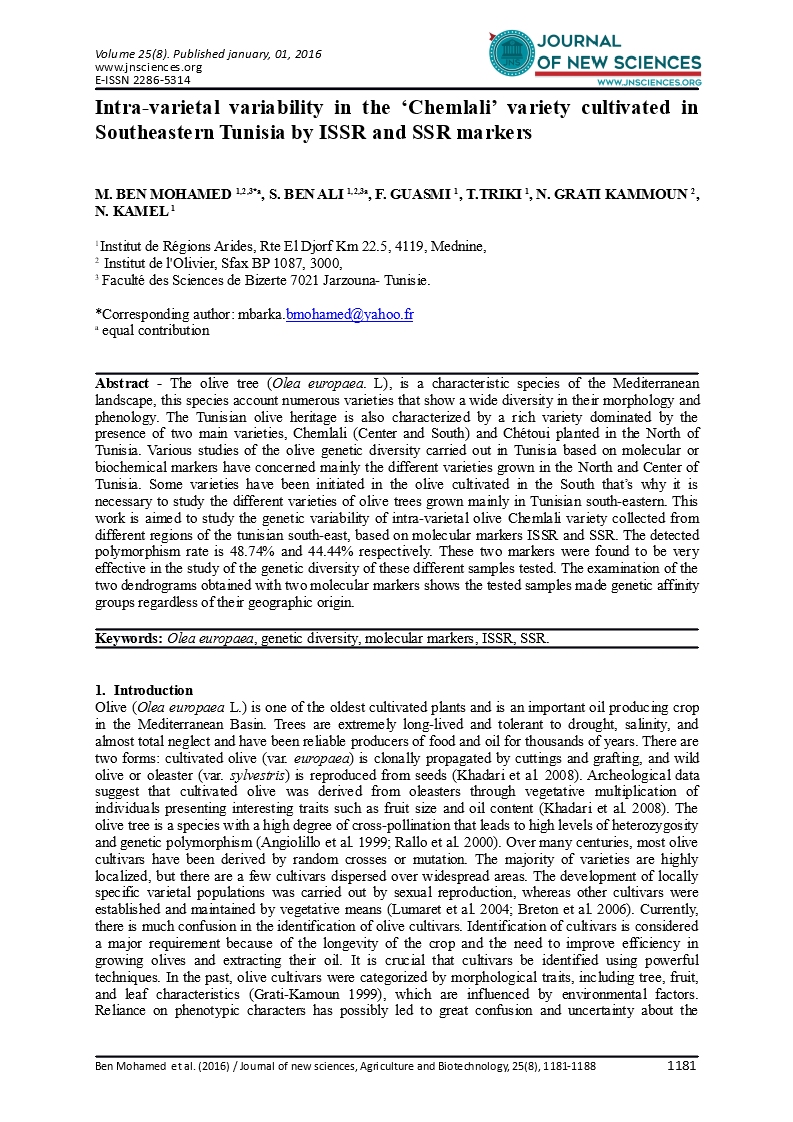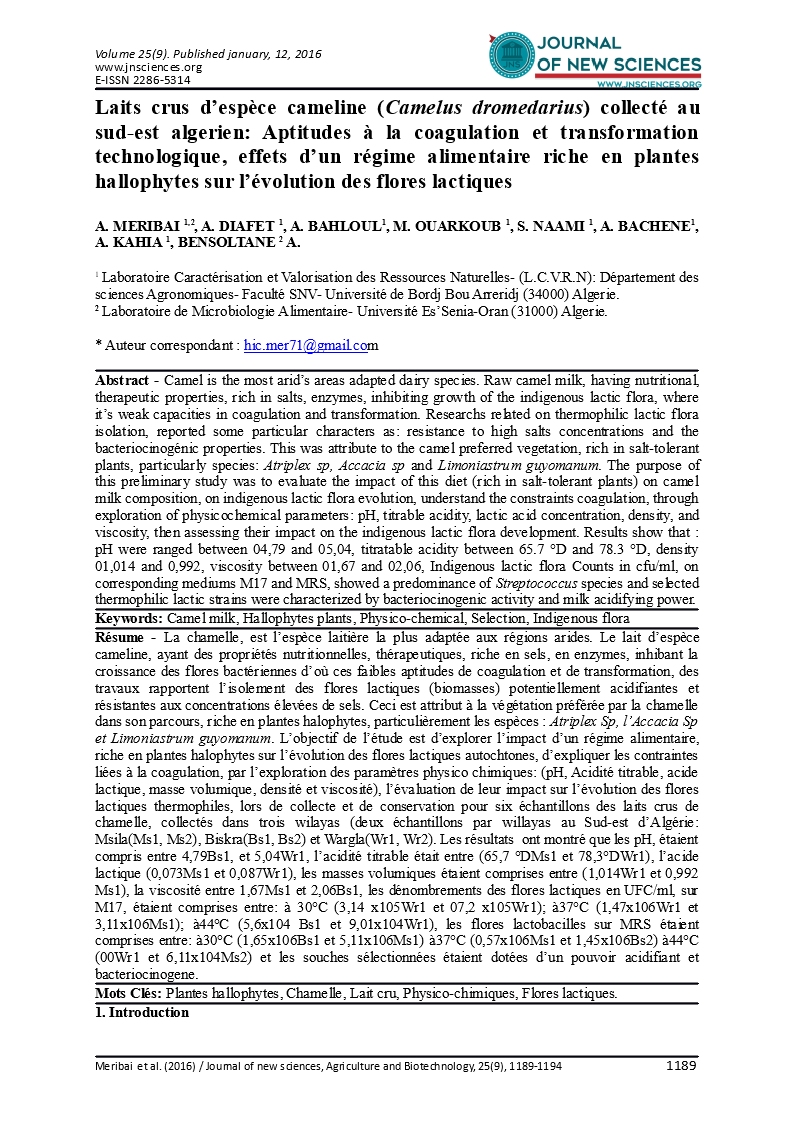A. Meribai 1,2
A. Diafet 1
A. Bahloul1
M. Ouarkoub 1
S. Naami 1
A. Bachene1
A. Kahia 1
A. Bensoltane 2
1 Laboratoire Caractérisation et Valorisation des Ressources Naturelles- (L.C.V.R.N): Département des sciences Agronomiques- Faculté SNV- Université de Bordj Bou Arreridj (34000) Algerie.
2 Laboratoire de Microbiologie Alimentaire- Université Es’Senia-Oran (31000) Algerie.
Abstract - Camel is the most arid’s areas adapted dairy species. Raw camel milk, having nutritional, therapeutic properties, rich in salts, enzymes, inhibiting growth of the indigenous lactic flora, where it’s weak capacities in coagulation and transformation. Researchs related on thermophilic lactic flora isolation, reported some particular characters as: resistance to high salts concentrations and the bacteriocinogénic properties. This was attribute to the camel preferred vegetation, rich in salt-tolerant plants, particularly species: Atriplex sp, Accacia sp and Limoniastrum guyomanum. The purpose of this preliminary study was to evaluate the impact of this diet (rich in salt-tolerant plants) on camel milk composition, on indigenous lactic flora evolution, understand the constraints coagulation, through exploration of physicochemical parameters: pH, titrable acidity, lactic acid concentration, density, and viscosity, then assessing their impact on the indigenous lactic flora development. Results show that : pH were ranged between 04,79 and 05,04, titratable acidity between 65.7 °D and 78.3 °D, density 01,014 and 0,992, viscosity between 01,67 and 02,06, Indigenous lactic flora Counts in cfu/ml, on corresponding mediums M17 and MRS, showed a predominance of Streptococcus species and selected thermophilic lactic strains were characterized by bacteriocinogenic activity and milk acidifying power.
Keywords: Camel milk, Hallophytes plants, Physico-chemical, Selection, Indigenous flora
Résume - La chamelle, est l’espèce laitière la plus adaptée aux régions arides. Le lait d’espèce cameline, ayant des propriétés nutritionnelles, thérapeutiques, riche en sels, en enzymes, inhibant la croissance des flores bactériennes d’où ces faibles aptitudes de coagulation et de transformation, des travaux rapportent l’isolement des flores lactiques (biomasses) potentiellement acidifiantes et résistantes aux concentrations élevées de sels. Ceci est attribut à la végétation préférée par la chamelle dans son parcours, riche en plantes halophytes, particulièrement les espèces : Atriplex Sp, l’Accacia Sp et Limoniastrum guyomanum. L’objectif de l’étude est d’explorer l’impact d’un régime alimentaire, riche en plantes halophytes sur l’évolution des flores lactiques autochtones, d’expliquer les contraintes liées à la coagulation, par l’exploration des paramètres physico chimiques: (pH, Acidité titrable, acide lactique, masse volumique, densité et viscosité), l’évaluation de leur impact sur l’évolution des flores lactiques thermophiles, lors de collecte et de conservation pour six échantillons des laits crus de chamelle, collectés dans trois wilayas (deux échantillons par willayas au Sud-est d’Algérie: Msila(Ms1, Ms2), Biskra(Bs1, Bs2) et Wargla(Wr1, Wr2). Les résultats ont montré que les pH, étaient compris entre 4,79Bs1, et 5,04Wr1, l’acidité titrable était entre (65,7 °DMs1 et 78,3°DWr1), l’acide lactique (0,073Ms1 et 0,087Wr1), les masses volumiques étaient comprises entre (1,014Wr1 et 0,992 Ms1), la viscosité entre 1,67Ms1 et 2,06Bs1, les dénombrements des flores lactiques en UFC/ml, sur M17, étaient comprises entre: à 30°C (3,14 x105Wr1 et 07,2 x105Wr1); à37°C (1,47x106Wr1 et 3,11x106Ms1); à44°C (5,6x104 Bs1 et 9,01x104Wr1), les flores lactobacilles sur MRS étaient comprises entre: à30°C (1,65x106Bs1 et 5,11x106Ms1) à37°C (0,57x106Ms1 et 1,45x106Bs2) à44°C (00Wr1 et 6,11x104Ms2) et les souches sélectionnées étaient dotées d’un pouvoir acidifiant et bacteriocinogene.
Mots Clés: Plantes hallophytes, Chamelle, Lait cru, Physico-chimiques, Flores lactiques.
Read more


